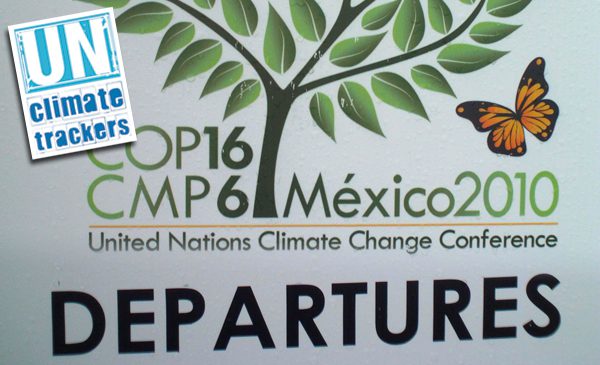
As another year of climate negotiations comes to an end there is cause for celebration.
In the final hours of a long and exhausting two weeks a firm foundation for a climate treaty was established and confidence in the UN process was renewed. It was an evening filled with drama and emotion that will be well remembered for years to come.
Until the final day in Cancun, the climate talks were on a disturbing trajectory. Progress had been far too slow and negotiators were frustrated. The all too familiar tensions and divisions were playing themselves out again. For example, many developed countries were refusing to commit to greenhouse gas reduction targets that science demands nor were they prepared to recognise the inadequacy of the targets they were offering. Vulnerable developing countries were concerned about the lack of firm financing commitments to help them cope with the impacts of climate change. Major developing economies like China were concerned about having their commitments internationally monitored.
On the final day of the negotiations I took the one to two-hour trek to the UN conference centre for one last time. The mood was low as many country representatives and observers were tired and exhausted from 12 long back-to-back days with little evidence of progress. The first open UN meeting of the day, a stocktaking session to identify where the negotiations were up to, was scheduled for 8:30am. Amidst much confusion this meeting was delayed for 10 hours.
As the final day rolled on, meeting after meeting was delayed. Many countries cancelled scheduled briefings with the media and observer organisations. In an ominous sign of what might have come, one country told all its observers to “have a safe trip, we hope to see you again back at home” well before the close of the conference. Formal negotiating sessions had been put on hold as ministers and heads of state met behind closed doors. We could only wait and speculate about what was occurring. However, at 3:00pm new documents were released that had been produced by the high-level meetings. These provided the first sign of hope.
Hundreds of people queued to get their hands on the new negotiating texts that would outline the nuts and bolts of a future climate agreement. Countries have been negotiating for years to find agreement on these details that may form the framework for future greenhouse gas reductions and outline how the most vulnerable will be assisted to cope with the impacts of climate change and transit to a low carbon economy. As we pored over the new documents it was clear that there had been progress made behind closed doors.
Over the past 24 hours it appeared that broad agreement had been reached on a number of key areas. For example, a clear process had been outlined to develop the global climate fund to assist developing countries deal with the impacts of climate change and follow a low carbon development pathway. In addition, there was a formal acknowledgement that there is a gap between current greenhouse gas reduction targets and what is needed to maintain a safe climate. More specifically, current developed country pledges equate to around a 13 -16 per cent reduction on 1990 levels by 2020 when the science suggests that these reductions need to be around 40 per cent. This may not sound like much, but it provides a space for countries to increase their ambition in the coming years in response to the science (problematically at one point during Cancun it looked like there would be provision for countries to reduce their targets). At 6:30pm in the evening we finally had the stocktaking meeting that was scheduled for 8:30am. What occurred caught everyone by surprise.
The coordinator of the talks in Cancun (formally called the ‘president’ of the meeting) officially presented the new text. She expressed that every country had been flexible over the past 24 hours and they had produced significant and groundbreaking agreements. As she finished her announcement the massive hall, packed with representatives from all countries and civil society, erupted in applause. It didn’t stop. After several minutes people started to stand and cheer. There was an electric enthusiasm in the room as the significance of the breakthrough sunk in.
The only task left for the negotiators in the final hours was for the new texts, documents that will form the basis of a new climate agreement, to be formally accepted by consensus. This session commenced at 11:00pm and ran until almost 8:00am the next morning. Despite some objections by a couple of countries, it was clear from the outset that the overwhelming majority supported the new texts. These late hours were marked by endless rounds of applause and a deep sense of renewed optimism for the UN climate negotiating process.
The deal that was struck in Cancun is not perfect. There is still a long way to go until these foundations are developed and cemented into a comprehensive, fair, ambitious and binding international treaty. The action in Cancun alone will not ensure a safe climate future, but it offers a lifeline to the United Nations Framework Convention on Climate Change and provides strong building blocks for a future treaty.
The outcomes and process of Cancun will inevitably have its detractors. But I for one am buoyed by the progress. After the disappointment of Copenhagen, the difficulties faced by climate legislation in Australia and the US and the increasingly stark scientific evidence of climate change impacts I think the Cancun outcome is cause for celebration. It offers us a glimpse of hope for international cooperation and action to tackle climate change. It is by no means the end. There is much hard work to be done. But when the going gets tough, as it inevitably will once more, I will remember the applause of Cancun and I will know that a safe climate for all is possible.
This article first appeared on ABC’s The Drum